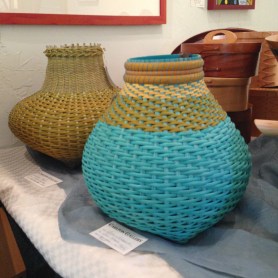
Clam Basket

Bushel Basket

Appalachian Egg Basket
It’s high time I did some posting. I have been very lax. I was very fortunate to be able to take a class with one of North Carolina’s ‘Living Treasures’, Billie Ruth Sudduth. She taught a class at Penland School of Crafts last July and I was able to attend.
She is most notably known for her ‘Cat Head’ baskets, hence my interest. I learned to make them from one of her books. This class was for “Big” baskets and that they were.
The extra large Calabash clam basket is 15″ in diameter. She named it after a tiny shrimping town on the southern coast of NC and the pattern is named for the bivalve clam. The Chevron pattern is a signature of the Chitimachas tribe of Indians from Louisiana.
This basket uses a ’twill’ weave which is any weave other than over one/under one. There are endless variations of twill weaves. This particular weave is over two/under one which creates an extremely strong basket.
The Bushel basket is 19″ high with a 12″ top diameter. It has multiple colors and is a simple over one/under one weave. We hand dyed all of our reed in this class. The handles are hand carved oak. And, no, I did not carve them myself. Good Grief! I guess you could use this as a laundry basket.
The egg basket is 19″ wide and 14″ deep. I have never seen an egg basket this large. The lashing which holds the two hoops together on each side is called an “ear”. There are different kinds of lashing. The most common one is a “God’s Eye” is a four point lashing. The one used here is a three point lashing, most commonly used in Southern Appalachia. It is also known as “donkey ears”.
We also made a large ‘cat head’ basket. I have not finished the rim yet. I am trying something a little different on that and will post it separately soon.

















